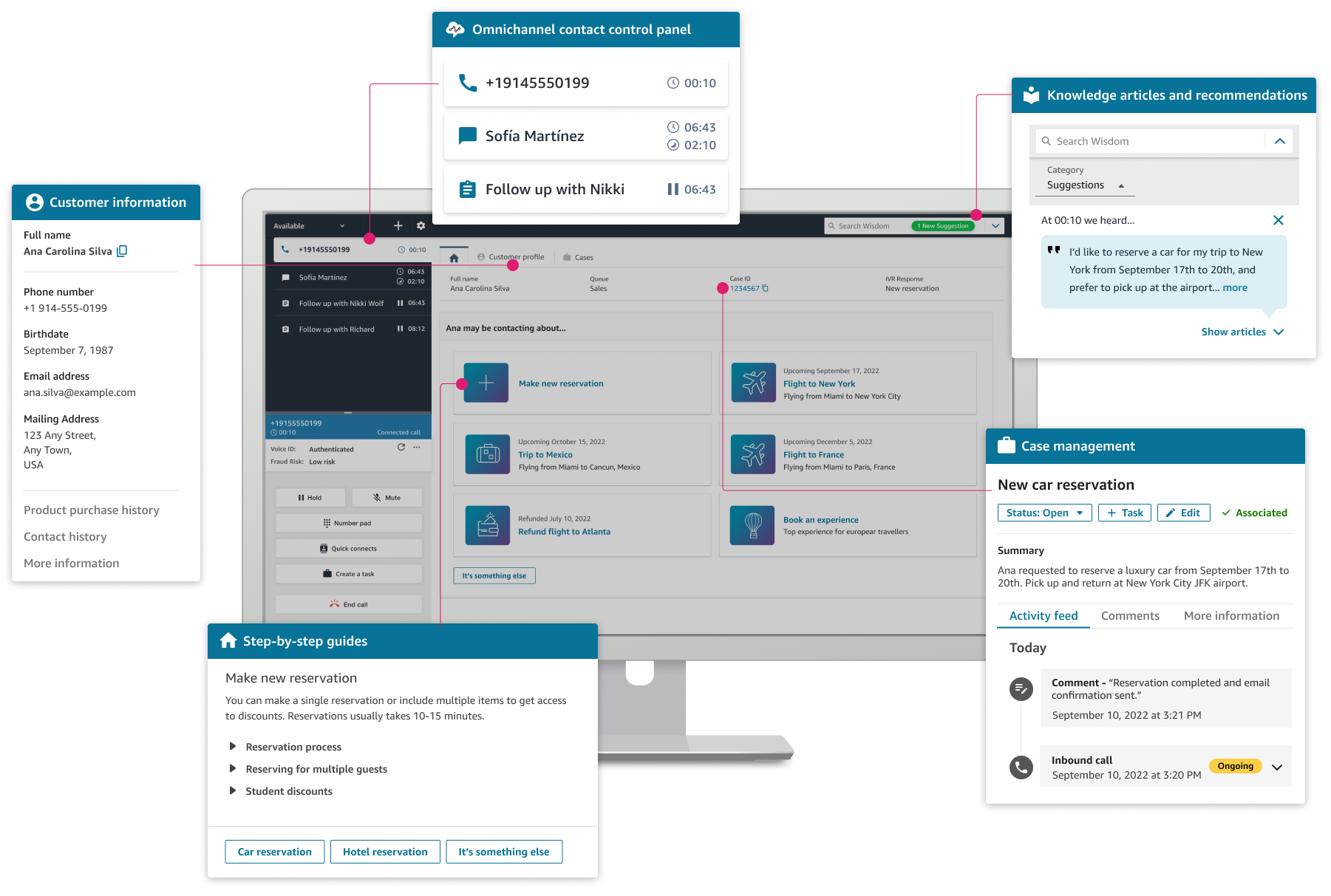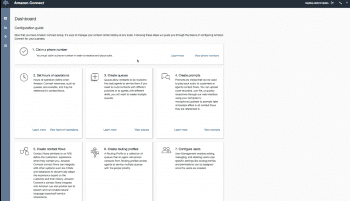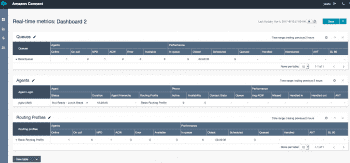Provider Overview
Companies today are increasingly reliant on cloud-based contact center solutions, like Amazon Connect from AWS services, to provide exceptional customer service across communication channels.
As a pay-as-you-go SaaS platform, Amazon Connect is a flexible, scalable, and cost-effective customer communication solution. In this article, we will review Amazon Connect and explore its features, benefits, and limitations to help you determine if it's the right solution for your contact center.
What is Amazon Connect?
Amazon Connect is a cloud contact center service offered by Amazon Web Services (AWS). It allows businesses to set up a desktop and mobile omnichannel contact center to streamline customer interactions across voice calling, chat, and email.

Unlike most other contact center software providers, Amazon Connect is a pay-as-you-go service. This means businesses only pay for the services they use–without any upfront costs or long-term commitments. Amazon Connect leverages other AWS services like Amazon Lex and AWS Lambda, making it an affordable and flexible option for businesses to improve customer service and support operations.
What Is It Used For?
Amazon Connect is used to facilitate customer interactions across various channels including voice, chat, and email. Amazon Connect's key features, like omnichannel support, case management, and IVR, improve the customer experience and boost agent and end users productivity.
Amazon Connect can also be used to set up a virtual contact center for remote teams, create a digital helpdesk, add self-service options like company website chatbots, or measure and improve contact center operations through forecasting, planning, and scheduling tools.
Amazon Connect Pricing
Amazon Connect operates on a pay-as-you-go model, so users are not obligated to pay any minimum monthly fees, upfront license charges, or commit to long-term contracts. Additionally, the pricing is not influenced by peak capacity, maintenance, or the number of agent seats. Users are only required to pay for the services they use.
Amazon Connect does offer a one-year free trial, which includes 90 usage minutes/month, a direct inward dial (DID) number, 500 messages/month, 100 tasks/month, and 90 days of Amazon Connect forecasting. After 12 months, Amazon Connect users pay only for what they use.
Below is a breakdown of features and usage costs:
| Feature |
Price |
| Inbound Voice |
$0.018 per minute |
| Outbound Calls |
$0.018 per minute |
| Outbound Campaign Voice usage |
$0.025 per minute |
| Chat |
$0.004 per message |
| Tasks |
$0.04 per task |
| Optimization (forecasting, capacity planning, and scheduling) |
$0.20 per work hour |
| Customer profiles using identity resolution or third-party data |
$0.0025 per profile stored per month |
| Voice ID usage |
$0.025 per transaction |
| Wisdom (allows agents to search connected databases to find information and resolve customer issues) |
$0.04 per contact |
The Key Features of Amazon Connect
Amazon Connect’s features are focused on improving customer service and business operations with flexible, AI-powered tools enhanced by machine learning.
Below are some of the key features of the Amazon Connect platform.
Agent Workspace
Amazon Connect’s Agent Workspace combines the contact control panel (CCP) and all contact center tools on a single pane of glass. As soon as an agent accepts a call, chat, or task, the Agent Workspace instantly displays customer history, suggested responses, and next-step recommendations. Agent Workspaces can also be used to provide step-by-step onboarding instructions in real time.

Amazon Connect admins create workflows with relevant, real-time instructions tailored to different types of customer interactions.
For example, when a customer contacts the company, the agent's workspace displays the most probable issue according to prior customer interaction data or current circumstances (like a missing order.) The workspace then assists the agent in taking the necessary actions to address the issue promptly (like placing a new order to replace the lost one). Agent workflows are modified using a no-code, drag-and-drop interface.
Contact Lens
Amazon Connect's Contact Lens feature allows users to interpret and categorize metrics such as the sentiment, patterns, and compliance of interactions through conversational analytics and quality management capabilities. These analytics, which become more accurate over time thanks to machine learning, can be leveraged to address customer concerns, improve agent performance, and identify valuable feedback.

Contact Lens displays (redactable) call recordings and transcripts, customer sentiment, quality issues, conversation summaries, contact details, and agent performance in real-time. Moreover, Contact Lens enables users to quickly search data and define agent performance criteria (e.g., adherence to scripts). Real-time alerts can be initiated to flag agent coaching opportunities. Contact Lens also has features that automatically complete evaluation forms and automatically score and populate criteria like script adherence, sensitive data collection, and customer greetings.
Customer Profiles
Amazon Connect's Customer Profiles feature is a current, comprehensive view of customer information compiled from Amazon Connect, integrated CRMs, and social media applications like LinkedIn. When a customer contacts the center, Customer Profiles scans and matches phone numbers or customer IDs to the relevant customer data. The agent is then presented with a unified profile in real-time, next to the softphone interface.

Customer Profiles combine contact history information from Amazon Connect (such as the number of holds, transcripts, and customer sentiment) with customer information like their phone number, address, and order status from third-party apps such as Salesforce, ServiceNow, Zendesk, Microsoft Dynamics and Marketo. Machine learning is used to detect and consolidate similar profiles based on names, email addresses, physical addresses, and phone numbers. Information from the customer profile can be used to personalize automated interactions and contact routing.
Analytics and Optimization Tools
Amazon Connect offers a feature called "Amazon Connect Forecasting, Capacity Planning, and Scheduling," which utilizes machine learning to predict, allocate, and ensure the appropriate number of agents are scheduled at the right time to meet operational targets without overstaffing.

The ML-powered forecasting feature allows users to accurately predict customer service workload, including contact volume and average handling time. Capacity planning is used to estimate how many full-time equivalent (FTE) agents are needed to meet service-level goals based on long-term forecasts. Users can also conduct what-if scenario analysis to set and improve service-level targets.
The scheduling tool automatically creates agent schedules based on short-term forecasts, shift patterns, and company policies. Schedules are displayed in Agent Workspaces and are accessible to supervisors to view and edit in real time. Employees can also be given the ability to choose when they work overtime or take time off within predetermined parameters.
Tasks

Amazon Connect’s tasks feature allows contact center agents to prioritize, track, manage, and automate contact center agent tasks. Agents can create and complete tasks within the same user interface used for taking calls and chats. Managers can monitor performance with detailed information such as arrival time and average handle time. Additionally, users can set up task automations by defining rules based on specific conditions.
Wisdom
Amazon Connect’s “Wisdom” feature combines various knowledge databases, including third-party applications like Salesforce and ServiceNow, internal wikis, FAQ stores, and file shares into a single searchable interface.

Agents use Wisdom to quickly browse connected repositories for relevant information to resolve customer issues.
Wisdom employs real-time speech analytics and natural language processing (NLP) capabilities from Contact Lens to identify customer issues during calls and provide agents with recommended answers. Agents can access Wisdom directly in Agent Workspace, or use the Amazon Connect API to embed Wisdom into an alternative agent desktop.
Call Routing
Amazon Connect has a single user interface (UI) across all channels for contact routing. Automated interactions and chatbots can be used to route calls across voice and chat. Customers can keep working with the same agent across channels or switch to a different agent with their interaction history preserved. Users can build call flows or contact flows, create rules, and generate reports once and facilitate their use across channels.
Amazon Connect also includes skills-based routing, which ensures contacts are sent to the right agent based on availability, skillset, customer sentiment, and past history. This helps agents quickly and efficiently resolve issues.
Voice ID

Amazon Connect Voice ID provides users with real-time caller authentication and fraud risk detection by analyzing unique voice characteristics like rhythm, pitch, and tone. Amazon Connect users can also create a custom watchlist. Voice ID analyzes incoming audio and compares it with recordings of persons on the watchlist. Suspicious callers are automatically flagged with a risk threshold (e.g. 'High Risk or 'Low Risk,') displayed to the agent.
Amazon Connect Pros and Cons
Below are some of the pros and cons of Amazon Connect.
| Advantages of Amazon Connect |
Disadvantages of Amazon Connect |
| Pay-as-you-go pricing model allows businesses to only pay for the services they need and the minutes they use |
Amazon Connect has a limited integration ecosystem |
| 12 month free trial includes a generous amount of minutes and features |
Lack of video conferencing |
| Easy to set up and use, with a user-friendly drag and drop interface and intuitive controls ideal for many use cases |
Lack of bundled plans makes Amazon Connect will be expensive for high-volume call centers and enterprises |
| Machine learning powered features for forecasting and scheduling |
Amazon Connect support is limited, users must purchase a separate customer support platform to access live support |
| Advanced productivity features including predictive dialer, omnichannel routing, and chatbots |
No guaranteed uptime SLA, reported voice quality issues |
Who Should Use Amazon Connect?
Amazon Connect is suitable for businesses of all sizes, however, due to its pay-as-you-go pricing model, it is an expensive option for high volume contact centers and does not offer the same level of reliability as more established CCaaS competitors such as Twilio and Genesys. Amazon Connect also lacks some more advanced contact center features such as video conferencing, queue callback, and post call survey. For these reasons, Amazon Connect is best for startups, solo entrepreneurs, and SMBs that require a telephony solution but have a somewhat low call volume.
Companies that experience dramatic seasonal shifts would benefit highly from Amazon Connect’s flexible pricing model. For startups on a tight budget, Amazon’s generous 12 month free trial offers a decent amount of minutes as well as a solid stack of features. Additionally, Amazon Connect is designed to be user-friendly and easy to set up, so small businesses without extensive technical expertise can still utilize it effectively.
















